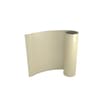LOCTITE ABLESTIK 561
Harmonization Code : 3920.99.28.90 | Other plates, sheets, film, foil and strip, of plastics, non-cellular and not reinforced, laminated, supported or similarly combined with other materials ; Of other plastics ; Other; Other
Main features
- Amber epoxy film
- Flexible & Reworkable
- Thermally conductive
Product Description
LOCTITE ABLESTIK 561 is designed for bonding materials with mismatched coefficients of thermal expansion. In many bonding applications, components may be repaired. This thermally conductive epoxy film is typically used for Assembly applications.
LOCTITE ABLESTIK 561 is reworkable, meaning that components glued with this adhesive can be debonded by heating the assembly to 150°C and sliding a thin blade, such as a razor blade, between the bonded surfaces. This adhesive is also available in a low temperature cure version.
Cure Schedule
- 30min @150°C
- 2 hours @ 125°C
Technical Specifications
| General Properties | |||||||
| |||||||
| Electrical Properties | |||||||
| |||||||
| Dielectric Strength Dielectric Strength Dielectric strength is measured in kV per mm and is calculated by the Breakdown voltage divided by the thickness of the tested material. Those two properties go hand in hand and while Breakdown voltage is always thickness dependent, dielectric strength is a general material property. As an example, the dielectric strength of Polyimide is 236 kV/mm. If we place 1mm of Polyimide between two electrodes, it will act as an insulator until the voltage between the electrodes reaches 236 kV. At this point it will start acting as a good conductor, causing sparks, potential punctures and current flow. | 39370 kV/mm | ||||||
| Volume Resistivity Volume Resistivity Volume resistivity, also called volume resistance, bulk resistance or bulk resistivity is a thickness dependent measurement of the resistivity of a material perpendicular to the plane of the surface. | 5.0x1012 Ohms⋅cm | ||||||
| |||||||
| Thermal Properties | |||||||
| |||||||
| Glass Transition Temperature (Tg) Glass Transition Temperature (Tg) The glass transition temperature for organic adhesives is a temperature region where the polymers change from glassy and brittle to soft and rubbery. Increasing the temperature further continues the softening process as the viscosity drops too. Temperatures between the glass transition temperature and below the decomposition point of the adhesive are the best region for bonding. The glass-transition temperature Tg of a material characterizes the range of temperatures over which this glass transition occurs. | 50 °C | ||||||
| Thermal Conductivity Thermal Conductivity Thermal conductivity describes the ability of a material to conduct heat. It is required by power packages in order to dissipate heat and maintain stable electrical performance. Thermal conductivity units are [W/(m K)] in the SI system and [Btu/(hr ft °F)] in the Imperial system. | 0.3 W/m.K | ||||||



